During the autumn excavation season in 2012 an interesting detail could be added to the PPN A monumental architecture at Göbekli Tepe.
Among the enclosures in the so-called main excavation area, Enclosure C stands out in particular due to several concentric, interleaved walls forming the characteristic circles of T-shaped pillars. The structure and layout of this peculiar enclosure changed signifanctly over time, hinting at a longer (re-)building history and life-cycle. For instance, an earlier entrance reminiscent of a dromos was blocked by an apparently later wall.
The supposed entrance is formed by two walls (made of noticeably large stones which are worked on all sides) running almost rectangularly towards the south and nearly parallel to each other. Almost like a barrier, a huge stone slab protrudes into this passage. Although the slab has not been completely preserved it is safe to say that once it had been provided with a central opening closed by asome stone-setting of which two layers still could have been observed in situ. At the slab’s southern side, looking away from Enclosure C and towards the visitor, there is the relief of a boar lying on its back right below the opening.
- This relief of a boar lying on its back was found on a porthole stone situated directly behind the U-shaped ‘door’ stone. (Photo: D. Johannes, DAI)
- Only partly excavated U-shaped ‘door’ stone (in front of another ‘porthole stone’). On the eastern side there probably was a counterpart (now lost) to the predator on the western part. (Drawing: K. Schmidt, DAI)
This relief-carved ‘porthole stone’ is accompanied by another building element. First, the sculpture of another animal was found right nin front of it, to the south: a beast of prey with a widely opened mouth, a lion or maybe a bear. In a distance of only 80 cm its counterpart was found, whose probably similarly sculpted head had been severed and is lost, unfortunately. As excavation went on it became clear that both actually belonged to just one large monolithic U-shaped workpiece. Apparently, together with the porthole slab it seems to have marked an entrance into this enclosure.
- Plan of Enclosure C indicating the position of the stairway discovered to the south of its possible entrance situation. (Plan: K. Schmidt, J. Notroff, DAI)
- So far eight steps of a stairway were discovered in the apparently more complex entrance situation of Enclosure D. (Photo: N. Becker, DAI)
A new element of this situation was unearthed recently: a stairway with (at current stage of excavation) so far eight stone-steps was discovered during field work in autumn 2012. It seems possible that these stairs once were constructed to bridge a hollow in the bedrock, leading up to Enclosure C’s orginial entrance, but further excavation work will be needed to entirely understand this situation.
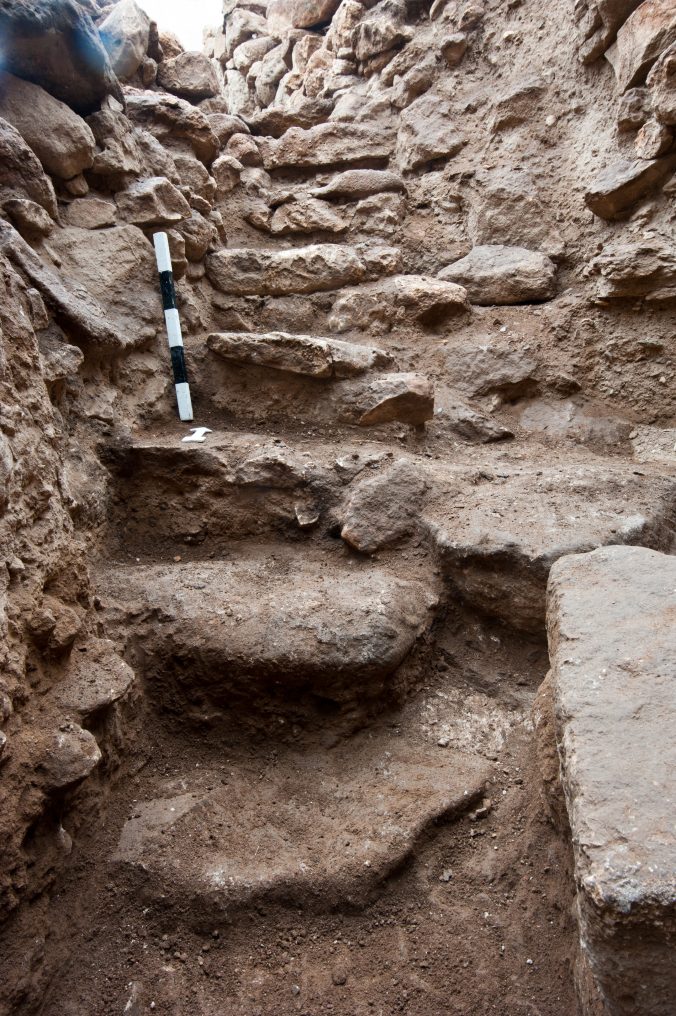
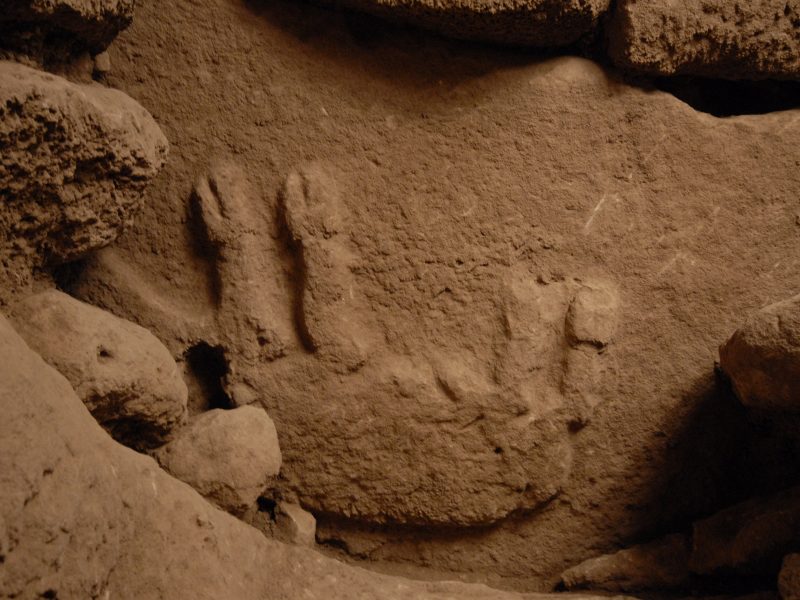
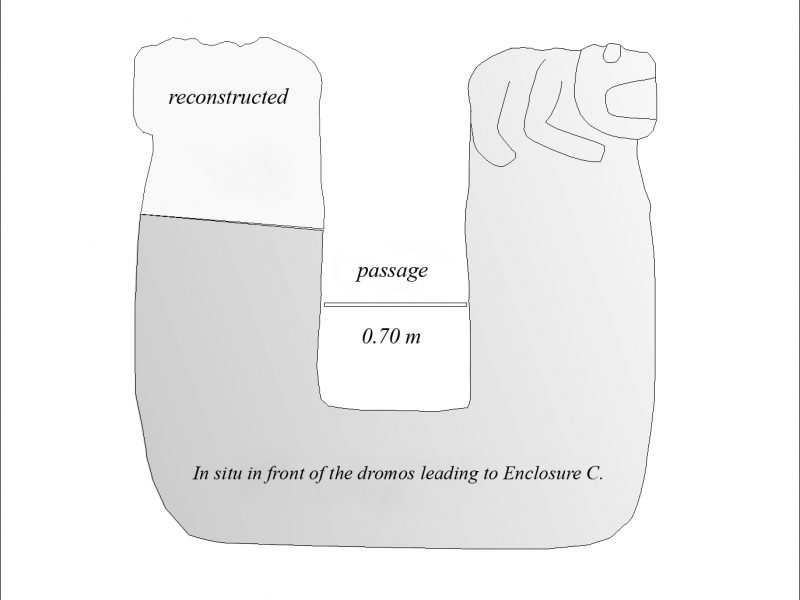
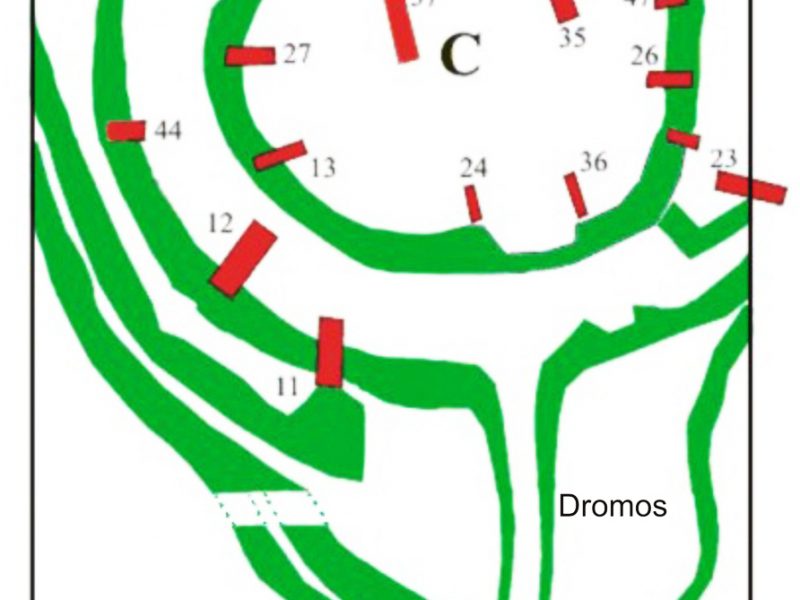
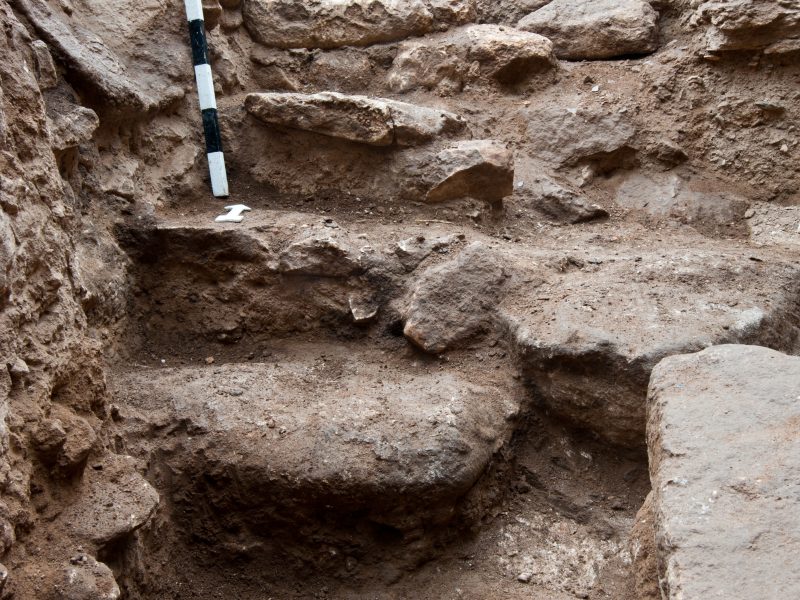
Here is my take on the upside-down boar, for whatever it’s worth : there’s every reason to believe that the celestial crescent, especially the lunation crescent, was regarded as a divine manifestation (hierophany, per Mircea Eliade) of the moon-god in the ancient Near East. In the Bronze Age, the moon was regarded as a bull, and the crown of bull’s horns was a sign of divinity in iconography. The “divine” crescent horn idea may have begun as early as the PPNA. The crescent moon, over lunation cycles, engages in reflections and rotations. In Tepe Gobekli’s iconography, crescents are indeed depicted (Are they all in the same orientation? I can’t remember), and the bull pictogram, showing off the crescent horns, is significant. The wild boar has crescent-shaped tusks, and its upside-down placement may have been to signify the moon during a particular lunation phase.
There certainly are crescent-like depictions (in particular the peculiar symbolism of Enclosure D’s central pillars comes to mind: one of those i.a. showing such a symbol in the neck area, maybe to be understand as a necklace or some very specific (i.e. identity-assigning) emblem). And it’s also true that the (characteristically ‘lying’) crescent moon is linked to bull’s horns in the ancient Orient. However, even without knowing if these really meant a particular lunation phase (or the moon at all), the appearance of these abstract crescent depictions at Göbekli Tepe at least suggests that PPN people also could have used a more simplistic mode of depicting such observations.
I’ve got to admit, however, I’m a bit hesitating regarding the application or emphasis of astronomic interpretation to every aspect of the iconography of the site (in particular in the light of recent discussions). Sometimes a boar maybe just means a boar …
I very much appreciate the information in your Tepe Telegrams; but I have one suggestion for improvement, one easy to implement: that you get a native English
speaker, best with a bit of editing experience, to put your language in more regular and correct English form. As the writing now appears, it’s very clear that the
writers think they know English well when, alas, they do not. At times this makes parts of the reports difficult to follow. I was for years a professional editor at the
University of Texas Press, then for decades a professor of literature at an Eastern U.S. college; and I would be happy to perform this service for you. You’d just
need to send me the proposed text, and since I’m retired now, I could get a revision back to you very quickly. If not me, then please find someone to do this!
All the best, Professor Frank Oatman
Thanks for your comment. It probably is no secret (and becomes quite apparent in our writing here) that we are no native speakers. This blog was meant to be a platform to provide a little insight into our research and work beyond academic publication. This does, of course, not mean it is of lower importance to us, but since we’re basically doing this here in our spare time, we did not want to make it a too complicated or complex thing (i.e. causing much work for other people – or editors at all). So, I really hope one or the other mistakes will be forgiven as long as the quintessence of each blogpost (the ‘hard facts’, so to say) gets across. Of course, if there is some really bad cruelty we’ve done to the English language I, personally, would not ignore any well-meant advice.
Thanks for your comment. I am really sorry to hear that our use of the English language seems so inappropiate to you. I assure you, it´s not the case that ” the writers think they know English well” or necessarily want to write in English. We are German native speakers, and mistakes are inevitable. Thanks for pointing that out so clearly. As German still is a lingua franca for some research areas within archaeology, I know that it can be difficult to understand the writings of non-native speakers. However, I generally appreciate when someone is making an effort in his second or third language to be understandable for me.
It would be much easier and faster to write in German, and probably also more logical, as it is the German Archaeological Institute excavating Göbekli Tepe. It would also make a lot of sense to write in Turkish, as this is the country the site is located in. Two languages that, alas, you may not know so well. What we are doing instead is to use English to reach as many readers as possible. If you get the basic information we want to offer here and it´s useful to you in some way, that´s great. If you don´t like what you are reading for some reason, you are free not to read this blog. Thanks again for your comment.
As a native English speaker living in another European country I know the pitfalls of communicating in a foreign language. To communicate one does not have to be perfect or grammatical or whatever. That is the beauty of language. So don’t bother with this petty criticism. You are both doing a fantastic job with this blog which is full of tremendous information and insight and so well formulated in English. Feel proud of your work which I think is very appreciated in so many parts of the world!!
I am engaged in a significant amount of scholarly editing too, and I really don’t think Frank Oatman meant to annoy any of you. The problem is that if you are going to write in any language that you are not fluent in, then there are three points to bear in mind:
1)keep the sentences brief;
2)make sure the tenses are correct; and
3)check that the plural and singular form of nouns and verbs are correct.
If you don’t, a lot can be VERY misunderstood. This does not mean all sentences should be 4 words long! It just means to avoid long sentences and check the 3 points. Also, if you wrote the Tepe Telegrams in German or Turkish, you would significantly narrow down the number of people able to visit your site.
There are several ways to express critique or offer help, and not all of them are constructive.
And yes, you are right, we would have considerably narrowed down the number of people able to understand the texts on the site by writing in German or Turkish – not necessarily the number of people able to visit it, which is a completely different thing :-). That is, as I tried to explain, the reason for writing in English.
Maybe you have a few examples from our site where things can be VERY misunderstood? We are definitely open for well-meant, concrete advice, as Jens said.
Otherwise, the site is just meant to offer information about our excavations – an offer you can refuse…
Will have a look through over the weekend and see what I can find. And yes, am very glad to read information about your excavations, and am glad your group offers to do so!
A few thoughts about communicating in foreign languages in 8×140 signs: https://twitter.com/In2thepast/status/862614243404853248
Any chance now to get back to discussing the archaeological finds?
So back to discussing archaeological finds. Why don’t you put equal emphasis on the stairs going down? It sort of means that up is better than down (if you want to get structuralist) and may give archaeoastronomers the wrong impression. Could going down after the experience in the enclosure also have been a significant part of the experience. I’m not referring to the incorporation phase of a rite de passage. Or maybe I am.
Good point you are raising here. Of course we do not know there these stairs lead to (or come from … depending on your perspective) since excavation’s not completed yet (it seems possible a natural gap in the bedrock needed to be bridged here for instance). For the time being we were focussing on the ‘entrance’ situation *into* the enclosure – thus emphasising this direction. But your argument of course is worth the discussing … once we know what’s on the other end of these steps. Leaving the enclosures is as important as entering them, I’m sure.
Well, previously i think could be very hard to find how the site was used at that level of detail, considering the enclosures were used over a long period and several pillars probably had some reuse and modifications, probably that kind of work implies several temporary constructions that today we find mixed with the original enclosure (i’m thinking in the pillars moved, the pits, etc.).
I think is good luck that the refill material contains organic material and in the end maybe we can find when was used every enclosure and when was filled and abandoned, but is remarkably brilliant as theories arise that explain how the site was built on itself and how its importance seems to be changing from the first enclosures on until impregnate the other nearby hills and reach Nevalı Çori to be finally abandoned.
This is not luck, this is Archeological science in action.
We are fortunate to have all these people working on the site and allow us to share this beautiful blog.
Could be possibly confirm that the refill material was a result of feasting in the moment of refilling the enclosure or was retrieved from garbage created during the construction of another enclosure? My point: could be possible analize the bones in the refill material to deduce if all the animals died in the same season? (could be done analizing growing rings in the bones par example if the conservation was good enough) just to confirm that the filling was a ritual procedure rather than a administrative decision.
This is indeed an interesting question – and one we are looking into as well. It seems indeed entirely possible that the material used to backfill the buildings was accumulated elsewhere over some time. However, the large number of animal bones make it unlikely that all of these come form a single one feasting event. Yet, as said: This is still subject of ongoing research.
Dear Jens Notroff,
First, thank you for always responding to these replies, I hope you still will at this late date. My question for reading your article: A Stairway to the Circle of Boars you write the entrance to enclosure C had two boars 80cm apart. The drawing of the entrance by K. Schmidt, DAI states the entrance width is 70cm wide. Is the discrepancy because the boars are above the passage of 70cm or is Dr. Schmidt’s drawing in error. Thank you for all your efforts in keeping people updated on Gobekli Tepe.